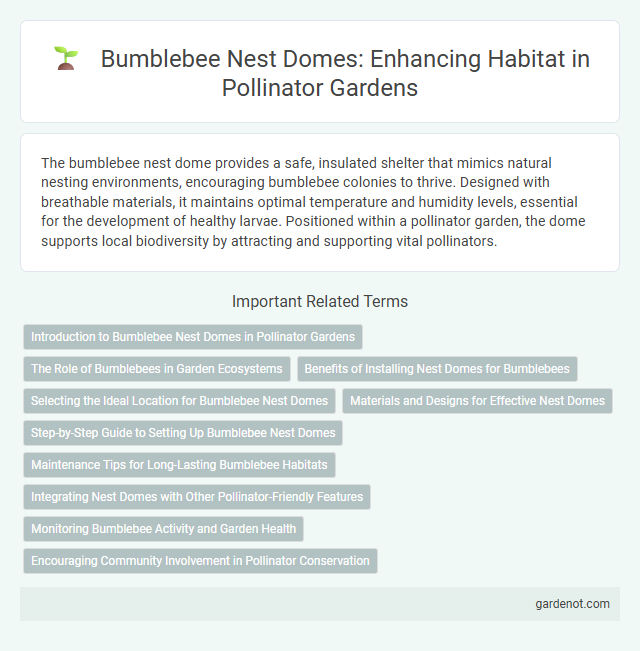The bumblebee nest dome provides a safe, insulated shelter that mimics natural nesting environments, encouraging bumblebee colonies to thrive. Designed with breathable materials, it maintains optimal temperature and humidity levels, essential for the development of healthy larvae. Positioned within a pollinator garden, the dome supports local biodiversity by attracting and supporting vital pollinators.
Introduction to Bumblebee Nest Domes in Pollinator Gardens
Bumblebee nest domes provide an essential habitat for native bumblebee species, supporting pollination in home and community gardens. These dome structures are designed to mimic natural nesting sites, offering shelter and protection from predators and harsh weather. Incorporating bumblebee nest domes in pollinator gardens enhances biodiversity and boosts the pollination of fruits, vegetables, and flowering plants.
The Role of Bumblebees in Garden Ecosystems
Bumblebee nest domes provide essential habitats that support the thriving population of bumblebees, key pollinators in garden ecosystems. Bumblebees enhance pollination efficiency, increasing the yield and diversity of flowering plants by transferring pollen between blossoms. Their presence promotes ecological balance by sustaining native plant species and fostering biodiversity within pollinator gardens.
Benefits of Installing Nest Domes for Bumblebees
Installing bumblebee nest domes provides a safe and insulated habitat that supports colony growth and enhances pollination efficiency in gardens. These domes protect bumblebees from harsh weather and predators, increasing their survival rates and promoting biodiversity. By fostering healthy bumblebee populations, nest domes contribute to improved crop yields and the sustainability of local ecosystems.
Selecting the Ideal Location for Bumblebee Nest Domes
Choosing the ideal location for a bumblebee nest dome requires a spot that is sheltered from strong winds and receives partial sunlight throughout the day to maintain optimal temperature. Placing the dome near diverse flowering plants ensures a steady food supply and enhances pollination efficiency. Avoid areas with heavy foot traffic or pesticide use to protect the bumblebee colony and promote sustainable garden health.
Materials and Designs for Effective Nest Domes
Bumblebee nest domes crafted from natural, breathable materials such as untreated wood and organic straw optimize ventilation and moisture control, creating a conducive environment for colony growth. Designs incorporating insulated walls and curved, dome-shaped roofs protect nests from extreme temperatures and rainfall while mimicking natural underground habitats. Incorporating removable panels or hinged lids facilitates easy monitoring and maintenance, enhancing hive health and sustainability.
Step-by-Step Guide to Setting Up Bumblebee Nest Domes
Constructing a bumblebee nest dome begins with selecting a shaded, undisturbed area featuring natural cover like grass or leaf litter to mimic their preferred nesting environment. Use breathable, weather-resistant materials such as untreated wood or wire mesh to build the dome structure, ensuring ventilation and protection against predators. Position the dome near flowering plants rich in nectar and pollen to support foraging, then monitor periodically to encourage colony establishment and growth.
Maintenance Tips for Long-Lasting Bumblebee Habitats
Regularly cleaning the Bumblebee nest dome with mild, non-toxic soap helps prevent mold and parasites that threaten colony health. Replacing bedding materials annually ensures a comfortable and hygienic environment for bumblebee queens to nest and reproduce. Positioning the dome in a shaded, dry location reduces exposure to extreme weather, enhancing the longevity of the bumblebee habitat.
Integrating Nest Domes with Other Pollinator-Friendly Features
Bumblebee nest domes can be seamlessly integrated with wildflower meadows and native plant borders to create a thriving pollinator garden that supports diverse species. Positioning nest domes near flowering shrubs and water sources enhances foraging opportunities and boosts bumblebee nesting success. Combining these features encourages a balanced ecosystem, promoting pollination and increased biodiversity in the garden.
Monitoring Bumblebee Activity and Garden Health
The Bumblebee Nest Dome enables precise monitoring of bumblebee activity patterns through real-time data collection on foraging frequency and nest temperature. Integrating this technology into pollinator gardens supports accurate assessments of colony health and early detection of environmental stressors. Continuous observation aids in optimizing garden conditions to enhance pollination efficiency and biodiversity.
Encouraging Community Involvement in Pollinator Conservation
Bumblebee nest domes serve as effective tools for engaging local communities in pollinator conservation by providing safe, accessible habitats that support native bumblebee populations. Installing these domes in public spaces and community gardens raises awareness about the critical role pollinators play in ecosystem health and food production. Collaborative efforts involving schools, gardeners, and conservation groups foster environmental stewardship and promote sustainable practices that enhance biodiversity.
Bumblebee nest dome Infographic

 gardenot.com
gardenot.com